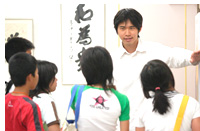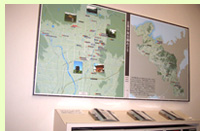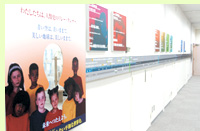| |


|
|
 |
 |
In this room we can learn about some of the ways the people of Kyoto have been involved in war, and also see some of the initiatives they have taken for peace. "A Tour of Kyoto Peace Sites" consists of maps identifying peace-related sites in the City of Kyoto and within Kyoto Prefecture and folders that contain interesting stories about each of these sites. The "International Children's Peace Sculpture" at
the far end of the room was created by students from high schools in Kyoto to
symbolize their desire for world peace. Hanging next to it is a picture of a
peaceful realm for children, made on a folding screen using Japan's famous yuzen
dyeing process. On the same wall there are also a number of "Peace Messages from Kyoto" written
by the head priests of famous Buddhist temples in Kyoto. The glass case on that
wall contains sheet music about Article 9 of the Japanese Constitution, which
renounces war. In addition,  the case holds a set of karuta playing cards on an
anti-nuclear war theme, along with the original illustrations for the cards,
as well as a Kyoto doll figurine called "The Sound of an Explosion", which shows a mother trying to protect her child during an air raid. Together, the displays in this room present another side of the city of Kyoto. the case holds a set of karuta playing cards on an
anti-nuclear war theme, along with the original illustrations for the cards,
as well as a Kyoto doll figurine called "The Sound of an Explosion", which shows a mother trying to protect her child during an air raid. Together, the displays in this room present another side of the city of Kyoto.
|
| |
 Tour of Kyoto Peace Sites Tour of Kyoto Peace Sites |
|
 These maps identify peace-related sites in the City of Kyoto and within Kyoto Prefecture, presenting a different slant on an area that is a popular tourist destination. There are three different kinds of sites featured on these maps: those related to war, peace and human rights. Detailed explanations of each spot in Japanese are found in the folders on the shelf below the maps. These maps identify peace-related sites in the City of Kyoto and within Kyoto Prefecture, presenting a different slant on an area that is a popular tourist destination. There are three different kinds of sites featured on these maps: those related to war, peace and human rights. Detailed explanations of each spot in Japanese are found in the folders on the shelf below the maps.
|
|
|
| |
 Timeline of Life on Earth Timeline of Life on Earth |
|
 On
the right-hand wall as you move from Rooms 1 to 3 on the second floor, you'll
find a timeline on which the 4.6 billion years of the earth's history are compared
to a single calendar year. Humanity doesn't even appear until the night of December
31st. At 23:59:58 on New Year's Eve, the Industrial Revolution flashes past,
followed by the development of nuclear weapons with just 0.4 seconds to go. This
timeline is designed to make us realize that human beings emerged only very recently
on the stage of global history, yet we are poised on the brink of obliterating
any trace of that history—along with all life itself. At the end of the timeline
is a mirror framed by children's faces.The reflection in the mirror represents
you as you are now, as well as the earth as it is now. As the message over the
mirror says, we are relay runners in human history. Let's make sure we pass the
baton to the next generation. On
the right-hand wall as you move from Rooms 1 to 3 on the second floor, you'll
find a timeline on which the 4.6 billion years of the earth's history are compared
to a single calendar year. Humanity doesn't even appear until the night of December
31st. At 23:59:58 on New Year's Eve, the Industrial Revolution flashes past,
followed by the development of nuclear weapons with just 0.4 seconds to go. This
timeline is designed to make us realize that human beings emerged only very recently
on the stage of global history, yet we are poised on the brink of obliterating
any trace of that history—along with all life itself. At the end of the timeline
is a mirror framed by children's faces.The reflection in the mirror represents
you as you are now, as well as the earth as it is now. As the message over the
mirror says, we are relay runners in human history. Let's make sure we pass the
baton to the next generation.
|
|
|
| |
|
|
|
 |
|
|
|